NCERT Solutions Class 7 Mathematics
Chapter – 11 (Perimeter and Area)
The NCERT Solutions in English Language for Class 7 Mathematics Chapter – 11 Perimeter and Area Exercise 11.4 has been provided here to help the students in solving the questions from this exercise.
Chapter : 11 Perimeter and Area
- NCERT Solution Class 7 Maths Exercise – 11.1
- NCERT Solution Class 7 Maths Exercise – 11.2
- NCERT Solution Class 7 Maths Exercise – 11.3
Exercise – 11.4
1. A garden is 90 m long and 75 m broad. A path 5 m wide is to be built outside and around it. Find the area of the path. Also find the area of the garden in hectare.
Solution –

Given that,
Length of the garden (L) = 90 m
Breadth of the garden (B) = 75 m
Area of the garden = length × breadth
= 90 m × 75 m
= 6750 m2
From the figure,
Length of the garden including path
= 90m + 5m + 5m = 100 m
Breadth of the garden including path
= 75m + 5m + 5m = 85m
Area of the garden including path
= l × b
= 100 m × 85 m = 8500 m2
Area of the path = 8500 m2 – 6750 m2 = 1750 m2
Hence, required area of path = 1750 m2
1 hectare = 10000 m2
Hence, area of garden in hectare = = 0.675 hectare
2. A 3 m wide path runs outside and around a rectangular park of length 125 m and breadth 65 m. Find the area of the path.
Solution –
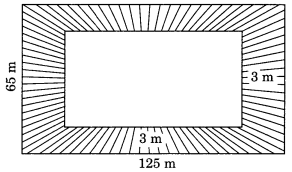
Given that,
Length of the park (L) = 125 m
Breadth of the park (B) = 65 m
Area of the park = length × breadth
= 125 m × 65 m
= 8125 m2
From the figure,
Length of the park including path = 125 m + 3m + 3m = 131 m
Breadth of the park including path = 65m + 3m + 3m = 71m
The area of path = New area of the park including path – Area of park.
Area of the park including path = 131 m × 71 m = 9301 m2
∴ Area of the path = 9301 m2 – 8125 m2 = 1176 m2
Hence, the required area = 1176 m2.
3. A picture is painted on a cardboard 8 cm long and 5 cm wide such that there is a margin of 1.5 cm along each of its sides. Find the total area of the margin.
Solution –
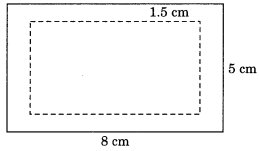
Given that,
Length of the cardboard (L) = 8 cm
Breadth of the cardboard (B) = 5 cm
Area of the cardboard = length × breadth
= 8 cm × 5 cm
= 40 cm2
From the figure,
Width of the margin = 1.5 cm
Length of the inner cardboard = 8 cm – 1.5 × 2 cm
= 8 cm – 3 cm = 5 cm
Breadth of the inner cardboard = 5 cm – 1.5 × 2 cm
= 5 cm – 3 cm = 2 cm
Area of the inner rectangle = l × b
= 5 cm × 2 cm = 10 cm2
The area of margin = Area of the cardboard when margin is including – Area of the
= 40 cm2 – 10 cm2 = 30 cm2
Hence, the required area = 30 cm2.
4. A verandah of width 2.25 m is constructed all along outside a room which is 5.5 m long and 4 m wide. Find:
(i) the area of the verandah.
(ii) the cost of cementing the floor of the verandah at the rate of ₹ 200 per m2.
Solution –

Given that,
Length of the room (L) = 5.5 m
Breadth of the room (B) = 4 m
Area of the room = length × breadth
= 5.5 m × 4 m
= 22 m2
From the figure,
Width of the verandah = 2.25 m
Length of the room including verandah = 5.5 m + 2 × 2.25 m
= 10 m
Breadth of the room including verandah = 4 m + 2 × 2.25 m
= 8.50 m2
Area of the room including verandah = l × b
= 10 m × 8.50 m
= 85 m2
(i)
The area of verandah = Area of the room when verandah is included – Area of the room
= 85 – 22
= 63 m2
(ii)
Given, the cost of cementing the floor of the verandah at the rate of ₹ 200 per m2
Then the cost of cementing the 63 m2 area of floor of the verandah = 200 × 63
= ₹ 12600
5. A path 1 m wide is built along the border and inside a square garden of side 30 m. Find:
(i) the area of the path
(ii) the cost of planting grass in the remaining portion of the garden at the rate of ₹ 40 per m2.
Solution –

Given that,
Side of square garden (s) = 30 m
Area of the square garden = (Side)2
= 30 m × 30 m = 900 m2
Length of the garden excluding the path = 30 m – 2 × 1 m = 28 m
∴ Area of the garden excluding the path = 28 m × 28 m = 784 m2
(i) The area of path = Area of the square garden when path is included – Area of the garden excluding the path
= 900 m2 – 784 m2
= 116 m2
(ii) Cost of the planting the remaining portion at the rate of ₹ 40 per m2
Then the cost of planting the grass in 784 m2 area of the garden = ₹ 40 × 784
= ₹ 31,360
6. Two cross roads, each of width 10 m, cut at right angles through the centre of a rectangular park of length 700 m and breadth 300 m and parallel to its sides. Find the area of the roads. Also find the area of the park excluding cross roads. Give the answer in hectares.
Solution –
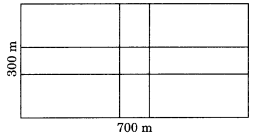
Given that,
Length of the road parallel to the length of the park = 700 m
Width of the road = 10 m
∴ Area of the road = l × b
= 700 m × 10 m
= 7000 m2
Length of the road parallel to the breadth of the park = 300 m
Width of the road = 10 m
Area of this road = l × b
= 300 m × 10 = 3000 m2
Area of the both roads
= 7000 m2 + 3000 m2 – Area of the common portion
= 10,000 m2 – 10 m × 10 m
= 10,000 m2 – 100 m2
= 9900 m2 = 0.99 hectare
Area of the park = l × b
= 700 m × 300 m
= 210000 m2
Area of the park excluding the roads
= 210000 m2 – 9900 m2
= 200100 m2 = 20.01 hectare
7. Through a rectangular field of length 90 m and breadth 60 m, two roads are constructed which are parallel to the sides and cut each other at right angles through the centre of the fields. If the width of each road is 3 m, find
(i) the area covered by the roads.
(ii) the cost of constructing the roads at the rate of ₹ 110 per m2.
Solution –
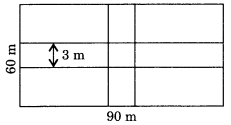
Given that,
Length of the road along the length of the field = 90 m
Breadth = 3 m
Area of the field = length × breadth
= 90 m × 3 m
= 270 m2
Similarly, the area of the road parallel to the breadth of the field = l × b
= 60 m × 3 m
= 180 m2
Area of the common portion
= 3m × 3m = 9m2
(i) Area of the two roads = 270 m2 + 180 m2 – 9 m2
= 450 m2 – 9 m2
= 441 m2
(ii) Cost of constructing the roads = ₹ 110 × 441
= ₹ 48,510
8. Pragya wrapped a cord around a circular pipe of radius 4 cm (adjoining figure) and cut off the length required of the cord. Then she wrapped it around a square box of side 4 cm (also shown). Did she have any cord left? (π = 3.14)
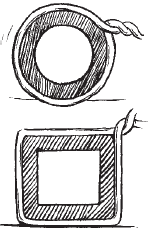
Solution –
Given that,
Radius of a circular pipe = 4 cm
Side of a square = 4 cm
Perimeter of the circular pipe = 2πr
= 2 × 3.14 × 4
= 25.12 cm
Perimeter of the square = 4 × side of the square
= 4 × 4
= 16 cm
So, the length of cord left with Pragya = Perimeter of circular pipe – Perimeter of square
= 25.12 – 16
= 9.12 cm
Yes, 9.12 cm cord is left.
9. The adjoining figure represents a rectangular lawn with a circular flower bed in the middle. Find:
(i) the area of the whole land
(ii) the area of the flower bed
(iii) the area of the lawn excluding the area of the flower bed
(iv) the circumference of the flower bed.
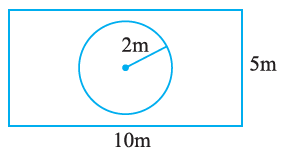
Solution –
(i) Length of rectangular lawn = 10 m
Breadth of rectangular lawn = 5 m
Area of the rectangular lawn = Length × Breadth
= 10 m × 5 m
= 50 m2
(ii) Radius of the flower bed = 2 m
Area of the flower bed = πr2
= 3.14 × 22
= 3.14 × 4
= 12.56 m2
(iii) The area of the lawn excluding the area of the flower bed = Area of rectangular lawn – Area of flower bed
= 50 – 12.56
= 37.44 m2
(iv) The circumference of the flower bed = 2πr
= 2 × 3.14 × 2
= 12.56 m
10. In the following figures, find the area of the shaded portions:

Solution –
(i) To find the area of EFDC, first we have to find the area of ΔAEF, ΔEBC and rectangle ABCD
Area of ΔAEF = ½ × Base × Height
= ½ × 6 × 10
= 1 × 3 × 10
= 30 cm2
Area of ΔEBC = ½ × Base × Height
= ½ × 8 × 10
= 1 × 4 × 10
= 40 cm2
Area of rectangle ABCD = length × breadth
= 18 × 10
= 180 cm2
Then,
Area of EFDC = ABCD area – (ΔAEF + ΔEBC)
= 180 – (30 + 40)
= 180 – 70
= 110 cm2
(ii) To find the area of ΔQTU, first we have to find the area of ΔSTU, ΔTPQ, ΔQRU and square PQRS
Area of ΔSTU = ½ × Base × Height
= ½ × 10 × 10
= 1 × 5 × 10
= 50 cm2
Area of ΔTPQ = ½ × Base × Height
= ½ × 10 × 20
= 1 × 5 × 20
= 100 cm2
Area of ΔQRU = ½ × Base × Height
= ½ × 10 × 20
= 1 × 5 × 20
= 100 cm2
Area of square PQRS = Side2
= 20 × 20
= 400 cm2
Then,
Area of ΔQTU = PQRS area – (ΔSTU + ΔTPQ + ΔQRU)
= 400 – (50 + 100 + 100)
= 400 – 250
= 150 cm2
11. Find the area of the quadrilateral ABCD. Here, AC = 22 cm, BM = 3 cm, DN = 3 cm, and BM ⊥ AC, DN ⊥ AC
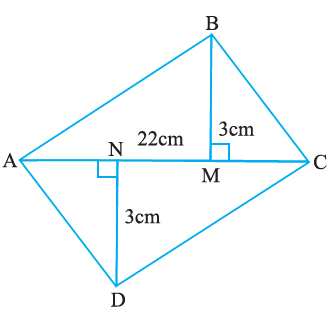
Solution –
Given that,
AC = 22 cm, BM = 3 cm DN = 3 cm and BM ⊥ AC, DN ⊥ AC
Area of ΔABC = ½ × Base × Height
= ½ × 22 × 3
= 1 × 11 × 3
= 33 cm2
Area of ΔADC = ½ × Base × Height
= ½ × 22 × 3
= 1 × 11 × 3
= 33 cm2
Area of the quadrilateral ABCD = Area of ∆ABC + Area of ∆ADC
= 33 cm2 + 33 cm2 = 66 cm2
Hence, the required area = 66 cm2.

Leave a Reply